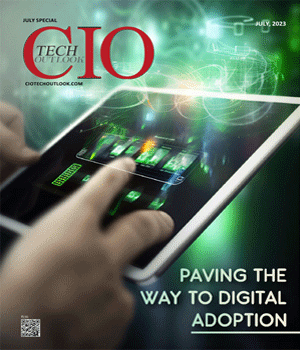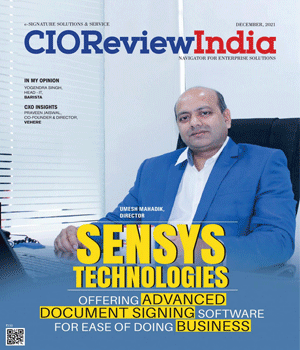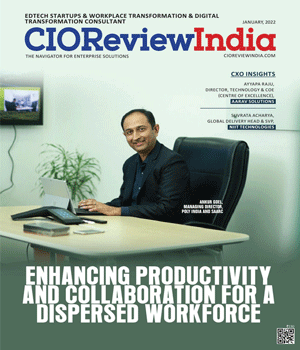
Upping the Digital Quotient of Customer Experience
Krishnan Venkateswaran, Chief Digital and Information Officer, Titan Company Limited | Tuesday, 25 August 2020, 05:00 IST

Krishnan Venkateswaran, Chief Digital and Information Officer, Titan Company Limited in an interaction with Sudhakar Singh, Editor, CIOReviewIndia, explained how retailers can address the challenges posed by the pandemic with the right technology adoption and business driven approach.
What are the major challenges thrown up by the pandemic, which are bothering CIOs the most and how are you addressing those challenges?
We are a lifestyle products company, the largest in the country and with a very wide network, arguably the biggest network at stores and still growing across multiple businesses and products. So, like other companies in our industry, we too have been affected by the fact that our customers are not able to visit our stores now with the same casual ease that they used to be able to. Therefore, the biggest challenge for digital teams like in Titan is to digitize the customer journey and the engagement to the extent that it comes as close as possible to an in-store experience.
We started our omni-channel journey several years ago. And what has happened now is obviously the acceleration brought upon with a pandemic. Since customers are not able to visit the stores easily, the importance of digital interactions has relatively spiked up tremendously. Therefore, we must enable digital interaction, and also strike a balance between physical and digital. For example, we have embarked on video calling. It sounds simple but when you do it at scale, the customer engagement effects become visible within the company and for the customers.
“We are fostering digital engagement with customers to the point where it really delivers an experience as close to the enjoyment of a face to face interaction with actual product.”
So, we are enabling our customers to create a wish list, book an appointment, have a video call, do the shortlisting and then come to the store. Our stores are following the highest safety standards in the industry. But even then customers would not feel comfortable about spending extended time. So, we are reducing the time which our customers need to spend at the store. We are fostering digital engagement with customers to the point where it really delivers an experience as close to the enjoyment of a face to face interaction with actual product.
There are increasing levels of sophistication which we are progressing on. But the overarching theme is that of digitizing engagement to the extent that customers find the productive product discovery and retail store engagement to be as effective or nearly as effective as a visit to the store.
How important is the role of AI in digital journey of a retailer? How can CIOs drive this change throughout their workflow?
If you take a typical life cycle journey, a customer visits the site and we are able to pop up a recommendation to the customer. You cannot generally say whether the customer has time to browse through an entire portfolio. But there are many customers who are willing to identify themselves to our system. For companies like us, who have had large loyalty programs, it gives us tremendous leverage. So, any effective implementation has to start with data collection and data enrichment. And organizations must understand their industry and the data levers thereof. We have a reasonable amount of data which our customers have been happy to share with us and we are able to reach out to a customer at the right time.
Then there is the critical question of how to embed it into the workflow. So, being able to pop up the right recommendation on the website really depends on the data collected about the customer for the last few months or years. Pre-processing or real time processing makes a really good guess on what the customers could be looking for.
“The workflow has to enable learning. The continuous process of refining has to be humanlike.”
However, these are not purely algorithmic. These are also driven by brand and product experts’ understanding of customer behavior. It is a mistake to assume that algorithms can completely substitute your expertise; they can't. So, it is important to be able to create what are called propensity models, essentially a human driven activity. But the algorithm obviously has the benefit of being able to scale. When you have hundreds of thousands of customers visiting a website, on weekends, and other busy days, festival days for example, the system is able to scale across all those interactions and keep popping up recommendations, which progressively become more and more attractive.
Also, the workflow has to enable learning. The continuous process of refining has to be humanlike. The idea that sometimes gets communicated to the media is that you can just take data, check it at an algorithm and start becoming insightful, which is exaggerated because data has to be collected in context. For example, non-purchaser data is also important.
How AR/VR and mixed reality can be leveraged to transform operations? What are the major impediments to its fast adoption in the current retail market?
AR/VR and mixed reality will absolutely transform the industry. The impediment to fast adoption is being able to meet the implementation challenge of producing something that's of good quality. There are many players in this industry of different sizes, but not all of them are sharp enough to deliver high quality in all contexts. For example, in the case of jewelry, to be able to make a piece of jewelry shine virtually just like the real one needs some artistic understanding as well. So, combining that domain and the aesthetic skill with the technology is really the game.
In what ways do you think retailers should change tack to keep up with the changing dynamics during the pandemic? How do you see the future of retail post pandemic?
As the digital quotient of interaction has gone up, we expect that customers will engage with us digitally first. Now that they know the technology is available and companies have invested in it, it is much easier for customers to visit the web, have an initial look, do an initial filtering and create an appointment with a wish list. We don’t know when the post-pandemic term will become a reality, but we are planning for caution. And therefore we foresee that even after the environment gets more comfortable, we'll prefer to interact digitally first, so that the core purpose of the visit is to surf quickly.
“We foresee that even after the environment gets more comfortable, we'll prefer to interact digitally first, so that the core purpose of the visit is to surf quickly.”
It is a question of the sophistication under evolution, and the AI backbone is also continuously scaling itself for all the touch points like we do recognize that there is a certain fatigue factor with email and SMS. So, we are looking for different methods of engagement, but all of them will be powered by some form of automation.
Digitizing the supply chain is also very important for companies like us. For example in eyewear we have rolled out a system by which females in remote areas can actually view our inventory and place an order and that's successfully rolling out.
As the current CIO of Titan, what is the most prominent challenge in front of you, which you have to address immediately?
It is the sheer scaling of digital engagement with our customers. We have to get customers to engage and think of buying. Our MD has also said this in multiple forums. We have to ensure that the desire to spend remains. The entire economy revolves around that. We are engaging with the customers to make sure that the pleasure of buying does not go away and how close can we come to the in-store experience. Creating that invention and bringing about the transformation is what is occupying us the most. We also need to facilitate that our supply chain partners can order with us extremely easily.
CIO Viewpoint
EdTech Business Models: Unlocking Success in...
By Atulya Kaushik, Co-founder and CEO of PrepInsta
CIO's Role in Driving Enterprise Sustainability
By Manoj Deorukhkar, Chief Information Officer at Sterling & Wilson Limited
Transforming employee experience through the...
By Prasad Ramakrishnan, CIO of Freshworks
CXO Insights
How leveraging technology solutions automates...
By Bimlesh Prasad
Why Digitalization is Crucial to Staying...
By Janifha Evangeline
How Digitization is Shattering Real Estate...












